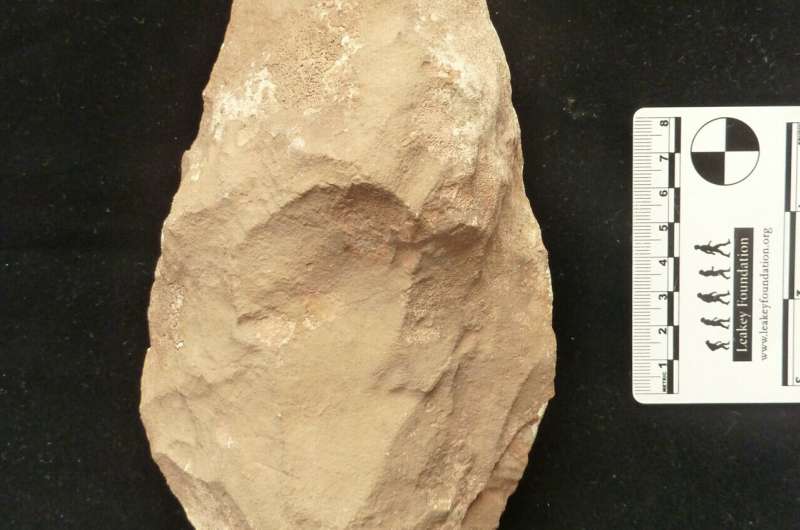Biface stone tool from Oued Boucherit (Algeria) dated to 1.7 million years. Credit: Mohamed Sahnouni
A new work published in the journal Quaternary Science Reviews, led by the Centro Nacional de Investigación sobre la Evolución Humana (CENIEH) in collaboration with the Centre National de Recherches Préhistoriques, Anthropologiques et Historiques (CNRPAH) (Algeria), describes the most recent advances in the current investigation performed in the valley of Oued Boucherit, located about 20 km east of the city of Sétif (Algeria).
There, the sedimentary deposits hosts a unique succession of fossiliferous and archaeological levels ranging from 3.9 Ma to 1.7 Ma. Perhaps the most noticeable outcome of this work is the discovery of the oldest evidence of Acheulean lithic industries in North Africa. Dated to 1.7 million years (Ma), it is about 400,000 years older than those recently reported at Thomas Quarry locality (Casablanca, Morocco).
"This is an exceptional discovery," says Dr. Mathieu Duval, Ramón y Cajal Researcher at CENIEH and lead author of the work, 'because it could drastically modify our vision and understanding of early human origins and migrations throughout the African continent."
While the French paleontologist Camille Arambourg already mentioned in the 1950s the presence of Acheulean lithic industries (typically characterized by the presence of tools like handaxes or picks) in that area, their exact origin has remained unclear until now. Field prospections carried out over the last years have allowed to find new lithic pieces, and more importantly, to define a clear stratigraphic context and provide an age.
In 2018, another important discovery from this same area was published in the journal Science: the oldest lithic industries (Oldowan-like; typically characterized by small flakes and pebble tools) in North Africa, dated to 2.4 Ma. "Now, Oued Boucherit hosts the oldest Oldowan and Acheulean lithic assemblages found in North Africa' says Prof. Mohamed Sahnouni, coordinator of the Archaeology Program at CENIEH and co-author of the work. "This area allows us to precisely study the emergence and evolution of Acheulean and Oldowan lithic industries, like perhaps very few other localities in Africa," adds the researcher who has been actively working in the area since the 1990s.
These discoveries drastically change our current vision about the origin and dispersion of the first lithic industries within Africa. Currently, the oldest Oldowan and Acheulean evidence are located in East Africa, dating to about 2.6 million years (Ma) and 1.8 Ma, respectively. Less than five years ago, the evidence was more than a half-million years older than those found in North Africa. Now, the recent discoveries made at Oued Boucherit indicate instead that these industries appear in North Africa very close in time to those in East Africa. While these results may suggest in first instance a much faster dispersion of these lithic industries from East Africa than previously anticipated, the plausibility of a multiple African origin scenario for stone tool manufacture and use cannot be discarded.
At the forefront of geochronology
"This work perfectly illustrates the reason why the Geochronology and Geology Program was designed' explains Prof. J.M. Parés, Coordinator of this Program and co-author of the article. "Thanks to a combination of various dating methods applied at CENIEH, namely palaeomagnetism and Electron Spin Resonance dating, we have been able to provide a solid chronological framework to such an old site, something perhaps unthinkable 20 years ago," concludes the researcher.
More information: Mathieu Duval et al, The Plio-Pleistocene sequence of Oued Boucherit (Algeria): A unique chronologically-constrained archaeological and palaeontological record in North Africa, Quaternary Science Reviews (2021). DOI: 10.1016/j.quascirev.2021.107116
Journal information: Quaternary Science Reviews
Provided by CENIEH
























